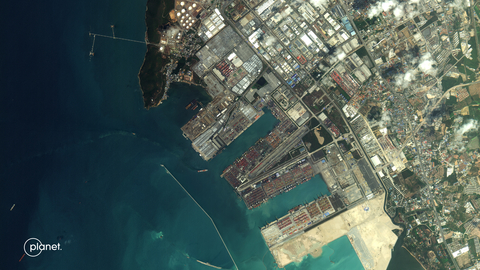Planet Labs PBC Releases Images From Pelican-2

Pelican-2 First Light imagery taken over the Port of Laem Chabang,
“We’re super pleased with our Pelican-2 first light imagery. The spacecraft is exceeding expectations and is rising to meet the market needs of our customers,” said Will Marshall, Co-Founder and CEO of Planet. “Our Pelican fleet offers greater capacity, higher resolution, lower latency, and, with NVIDIA’s most powerful chip onboard, Pelican will be able to do AI processing at the edge. This integration of AI-powered solutions with our precise spatial data is a major leap forward, and is an exciting preview of what’s to come for commercial satellite imagery data in the years ahead.”
Pelican-2 joins Pelican-1 (a smallsat platform tech demonstration launched last year) as part of Planet’s next-generation, high-resolution fleet to support and expand its existing SkySat capabilities. Pelican-2 provides high resolution imagery by leveraging 6 multispectral bands that are optimized for cross-sensor analysis with PlanetScope. Pelican-2 will support Planet’s 50 cm tasked imagery product line and is engineered to produce 40 cm class imagery.
Planet has collaborated with NVIDIA to equip Pelican-2 with the NVIDIA Jetson platform to power on-orbit computing—with the aim of vastly reducing the time between data capture and value for customers. Additional imagery with an increased resolution is expected to be available following the lowering of the spacecraft to its operational altitude and once the spacecraft and the imagery pipelines complete ongoing commissioning and calibration work. Planet plans to launch additional Pelicans this year.
“I’m deeply proud of the Pelican team that made this achievement possible. The data we’re getting back from the early stages of our Pelican-2 satellite proves the technical maturity of this new system, and is a testament to their hard work,” said Brian Lewis, Mission Director, Pelican. “Pelican’s ability to reduce downlink latency while improving our image quality and capabilities will help ensure our customers and partners have a seamless tasking experience and can consistently monitor critical changes happening on the ground. This is just the beginning of the high-resolution imagery we plan to more rapidly provide, and we can’t wait to make these capabilities available for a wide range of use cases – from defense and intelligence monitoring to disaster response and more.”
More information on Pelican-2’s capabilities can be found here.
About Planet Labs PBC
Planet is a leading provider of global, daily satellite imagery and geospatial solutions. Planet is driven by a mission to image the world every day, and make change visible, accessible and actionable. Founded in 2010 by three NASA scientists, Planet designs, builds, and operates the largest Earth observation fleet of imaging satellites. Planet provides mission-critical data, advanced insights, and software solutions to approximately 1,000 customers, comprising the world’s leading agriculture, forestry, intelligence, education and finance companies and government agencies, enabling users to simply and effectively derive unique value from satellite imagery. Planet is a public benefit corporation listed on the New York Stock Exchange as PL. To learn more visit www.planet.com and follow us on X (formerly Twitter).
Forward Looking Statements
Except for the historical information contained herein, the matters set forth in this press release are forward-looking statements within the meaning of the "safe harbor" provisions of the Private Securities Litigation Reform Act of 1995, including, but not limited to, the Company’s ability to capture market opportunity and realize any of the potential benefits from current or future product enhancements, new products, or strategic partnerships and customer collaborations, the Company’s ability to successfully design, build, launch and deploy, operate and market new products and satellites and the Company’s ability to realize any of the potential benefits from product and satellite launches, either as designed, within the expected time frame, in a cost-effective manner, or at all. Forward-looking statements are based on the Company’s management’s beliefs, as well as assumptions made by, and information currently available to them. Because such statements are based on expectations as to future events and results and are not statements of fact, actual results may differ materially from those projected. Factors which may cause actual results to differ materially from current expectations include, but are not limited to the Company’s ability to obtain and maintain required licenses and approvals from regulatory agencies, such as the Federal Communications Commission (FCC), in a timely fashion, or at all; whether the Company will be able to successfully build, launch and deploy or operate its satellites, including new satellites either as designed, in a timely fashion or at all; the Company’s ability to develop and release product and service enhancements to respond to rapid technological change, or to develop new designs and technologies for its satellites, in a timely and cost-effective manner; whether the Company will be able to continue to invest in scaling its sales organization, expanding its software engineering (including its ability to integrate new satellite capabilities) and marketing capabilities; whether the Company will be able to accurately predict and capture market opportunity; whether current customers or prospective customers adopt the Company’s platform or new products; the Company’s ability realize any of the potential benefits from new products and satellites, as well as strategic partnerships and customer collaborations; and other risk factors and disclosures about the Company and its business included in the Company's periodic reports, proxy statements, and other disclosure materials filed from time to time with the Securities and Exchange Commission (SEC) which are available online at www.sec.gov, and on the Company's website at www.planet.com. All forward-looking statements reflect the Company’s beliefs and assumptions only as of the date such statements are made. The Company undertakes no obligation to update forward-looking statements to reflect future events or circumstances.
View source version on businesswire.com: https://www.businesswire.com/news/home/20250320918015/en/
Planet Press
Claire Bentley Dale
press@planet.com
Planet Investor Relations
Cleo Palmer-Poroner
ir@Planet.com
Source: Planet







